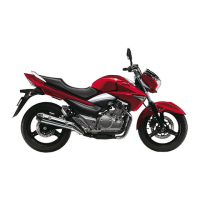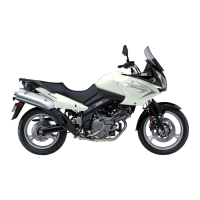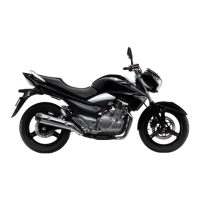Inspection
1.
With
a feeler gauge check the side clearance
of the
connecting
rods. (See Figure 3-80.) The
correct tolerance
is
0.016-0.020
in. (0.4-
0.5
mm). If
the
clearance is greater
than
th
is re-
place
the
crankshaft
assembly.
Figure
3-80
2.
Check the
crankshaft
center bearings for
wear
or rough spots. If the
center
bearings
show
wear
or have rough spots replace
the
crank-
shaft
assembly.
3.
To
check the connecting rod radial clearance,
set
up
the
crankshaft
as
shown
in Figu
re
3-81
with
a dial indicator.
With
the
connecting rod
perpendicular
pull
the
connecting rod up
toward
the dial indicator. Then push
the
con-
necting rod
down
towards
the
crank pin. The
difference
between t hese
two
readings is
the
radial clearance. The
allowable
radial clear-
ance is
0.0008
-0
.001 in. (0.02-0.03 mm),
if
the
radial clearance exceeds these
dimensions
re-
place the crankshaft assembly.
Figure 3-81
4.
If
the
outer bearings, seals or oil pump drive
gear require replacement, remove these parts
with
a bearing puller. (See Figure 3-82.) Never
hammer
on the bearings or crankshaft to
re
-
move these parts.
When
installing
the
bearing or gear, heat the
parts
with
a heat gun or place on top of a li
ght
bulb. The parts
will
expand for easy in-
stallation.
Figure
3-82
5.
If the
outer
bearings
on
either
end have been
replaced or a
new
oil
pump
dr
i
ve
gear
has
been pressed onto
the
crankshaft, the crank-
shaft
must
be
checked
for
alignment. Place the
crankshaft on V-blocks and use a dial indi-
cator
as
shown
in Figure
3-83
to check the
alignment.
Maximum
run
out
permissable
is
0.002
in. (0.05 mm) T
IR
(Total Indicated
Reading). If
the
run
out
exceeds this
dimen
-
sion replace the
crankshaft
assembly.
Figure
3-83
CRANKSHAFT
ASSEMBLY
3-63

